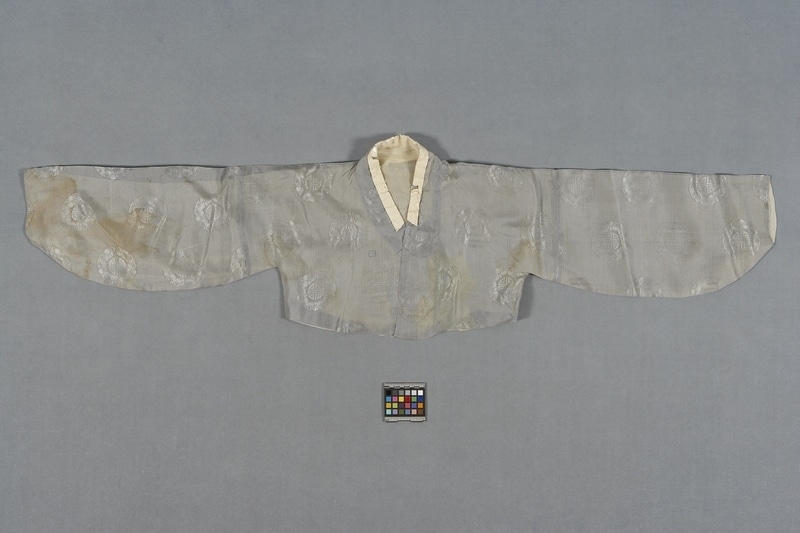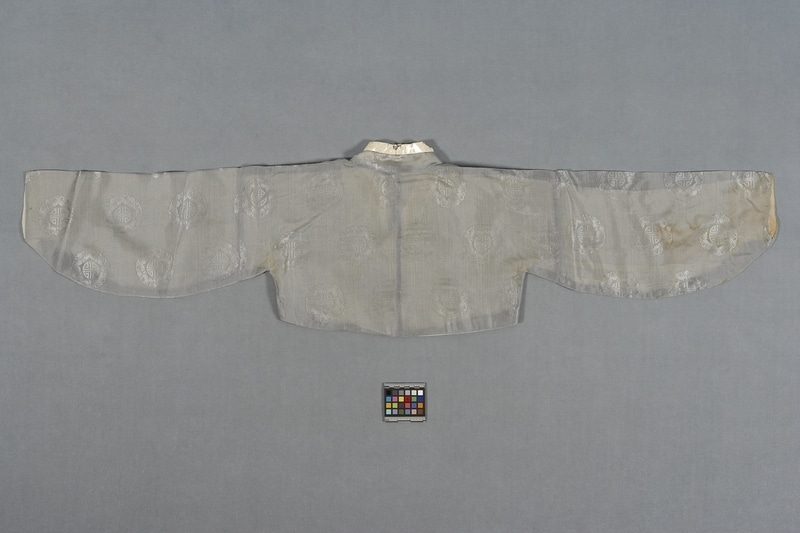Jacket Item Number: Ed1.323 from the MOA: University of British Columbia


Description
Upper body garment made of lightweight grey silk gauze patterned with roundels of bats surrounding a circular form of wide lines forming an even cross with arms curving around and bent inwards. The gauze fabric has an overall pattern of small rectangles. The garment is lined with loosely woven white silk. The long sleeves are inset with straight seams. The seam of the sleeves, under the arms, has a pronounced convex curve, narrowing to the wrist. The body of the garment curves downwards to the centre front. It opens at the front, and the front edges are extended with panels extending down from the mid-point of the outer facing. The front panels overlap to the left when closed. The left side has a small fabric triangle attached where the outer facing meets the front edge. The left outer facing is rounded at the lower edge, while that on the left is straight and projects beyond the front edge of the garment. On the right side a small square fabric tab is attached. There is also a narrow facing or collar of white shiny paper, which is partially detached and broken in many places.
History Of Use
Such “Jo-go-ri”, made of extravagant gauze fabrics were favoured in the postwar period. During the 1950s the underarm seams were longer than those worn both previously and later, and the garment as a whole was wider, making it more comfortable. The curve at the lower edge of the sleeve was deeply rounded at this time. Such clothing was worn my middle- and upper-middle class women in the home, while working. Graceful curves, like those at the lower edge of this garment, are important in Korean aesthetics and reflected in various forms, including architecture.
Iconographic Meaning
The bat is a symbol of good fortune.
Specific Techniques
The garment is machine sewn except for the stitches attaching the white collar, which are done by hand.
Narrative
Worn by Norma Elrod while living in Korea. This jackett would be worn with skirt Ed1.324.Most of the clothing in the J. McRee Elrod Collection was made for him and his family by friends while they were living in Korea, much of it by Kim, Sung Sook. She and her family lived cooperatively in the same house as the Elrod family. While they were there, the Elrods preferred to wear Korean clothing on very cold days and for social occasions. They found it to be more comfortable than western clothing in cold weather, as public buildings were unheated in the period immediately following the Korean War. It also was more comfortable for floor seating in Korean homes, and easier to store with limited furniture than western clothing.
Item History
- Made by Sung Sook Kim (Maker) in Seoul, Korea between 1955 and 1960
- Collected between 1955 and 1960
- Owned by Norma Elrod
- Owned by J. McRee Elrod before October 13, 1976
- Received from J. McRee Elrod (Donor) on October 13, 1976
What
Who
- Culture
- Korean
- Creator
- Sung Sook Kim (Maker)
- Previous Owner
- Norma Elrod and J. McRee Elrod
- Received from
- J. McRee Elrod (Donor)
Where
- Holding Institution
- MOA: University of British Columbia
- Made in
- Seoul, Korea
When
- Creation Date
- between 1955 and 1960
- Collection Date
- between 1955 and 1960
- Ownership Date
- before October 13, 1976
- Acquisition Date
- on October 13, 1976
Other
- Item Classes
- textiles
- Condition
- fair
- Accession Number
- 0335/0007 a